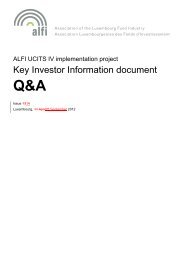Real Estate Investment Funds: Financial reporting - Alfi
Real Estate Investment Funds: Financial reporting - Alfi
Real Estate Investment Funds: Financial reporting - Alfi
You also want an ePaper? Increase the reach of your titles
YUMPU automatically turns print PDFs into web optimized ePapers that Google loves.
accounting<br />
(i.e. the fair value of the real estate asset) is<br />
based on the future cash flows of the real<br />
estate asset and some of these future cash<br />
flows have already been included as an<br />
asset on the balance sheet in the form of a<br />
lease receivable. In the end, the lease<br />
receivable plus the value of the investment<br />
property should be equal to the fair value<br />
of the real estate asset determined with the<br />
fair value model.<br />
6. What is the<br />
accounting treatment<br />
for property acquisition<br />
costs?<br />
a. Under both LuxGAAP and IFRS, such costs<br />
must be initially capitalised. Subsequent fair<br />
value re-measurement does not take them<br />
into account as fair value excludes costs<br />
normally borne by the purchaser and does<br />
not take account of potential disposal costs<br />
of the seller. Effectively they are therefore<br />
written off through the income statement at<br />
the next NAV determination date,<br />
irrespective of whether it coincides with<br />
independent valuation on that date.<br />
b. Often, to ensure that such transaction costs are<br />
borne proportionately by investors coming into<br />
the fund after the portfolio has been<br />
established, a swing pricing mechanism can be<br />
used to adjust the Fund NAV offered to new<br />
investors to add a premium to cover<br />
transaction costs borne by existing investors.<br />
Premiums or discounts to Fund NAV as part of<br />
a pricing scheme are recorded directly in equity.<br />
c. Alternatively, to comply with INREV<br />
guidelines, an adjustment could be made to<br />
the underlying IFRS/LuxGAAP NAV basis<br />
for the capitalisation and amortisation<br />
(generally over 5 years, can be shorter if the<br />
rationale is justified) of acquisition costs to<br />
reflect in the NAV a fairer spreading of such<br />
costs between investors. If the property is<br />
sold before the amortisation period expires,<br />
the remaining adjustment (unamortised part)<br />
should no longer be included in the IFRS/<br />
LuxGAAP NAV.<br />
d. Alternatively, an up-front subscription and/<br />
or redemption fee is charged on units/shares<br />
offered or redeemed at NAV. Up-front fees<br />
are recorded as income in the fund either at<br />
the date of issue/redemption of the units/<br />
shares, or over a certain period of time.<br />
7. What is the<br />
recommended<br />
treatment of fund<br />
formation costs?<br />
a. Under LuxGAAP, such costs can be<br />
capitalised and amortised over a period not<br />
exceeding 5 years.<br />
b. Under IFRS, general fund launch costs must<br />
be written off immediately through the<br />
income statement. Costs directly associated<br />
with raising equity must be shown as a<br />
deduction to the proceeds raised from<br />
capital formation.<br />
c. For many Luxembourg REIFs which<br />
prepare IFRS financial statements,<br />
amortisation adjustments are made to the<br />
Investors Equity in the financial statements<br />
prepared under IFRS to reflect in the Fund<br />
NAV a fairer spreading of such costs<br />
between investors over the first 5 years of<br />
the fund. This adjustment is in line with<br />
INREV guidelines.<br />
8. What is the method<br />
of accounting for<br />
performance fees/<br />
carried interest?<br />
a. Performance fees generally represent<br />
financial incentives given to asset managers<br />
of funds to meet and exceed certain<br />
financial targets over the life of the fund.<br />
Generally they are structured as a kind of<br />
profit sharing arrangement between<br />
investors and the asset manager which is<br />
triggered based on certain targets being<br />
achieved either in a given financial period,<br />
on a cumulative basis over the life of a<br />
closed ended fund, or on a series of<br />
successive years in an open ended fund.<br />
b. Performance fees represent either:<br />
a contingency of the fund which has not<br />
yet become a determinable or contractual<br />
obligation triggered by certain events or<br />
economic conditions, or<br />
an amount which has been earned and can<br />
be estimated or calculated and accrued for<br />
or invoiced as a liability of the fund.<br />
c. Where performance fees are a contingent<br />
liability of the fund, they should be disclosed<br />
in the notes to the financial statements,<br />
giving enough information for the reader to<br />
16

















